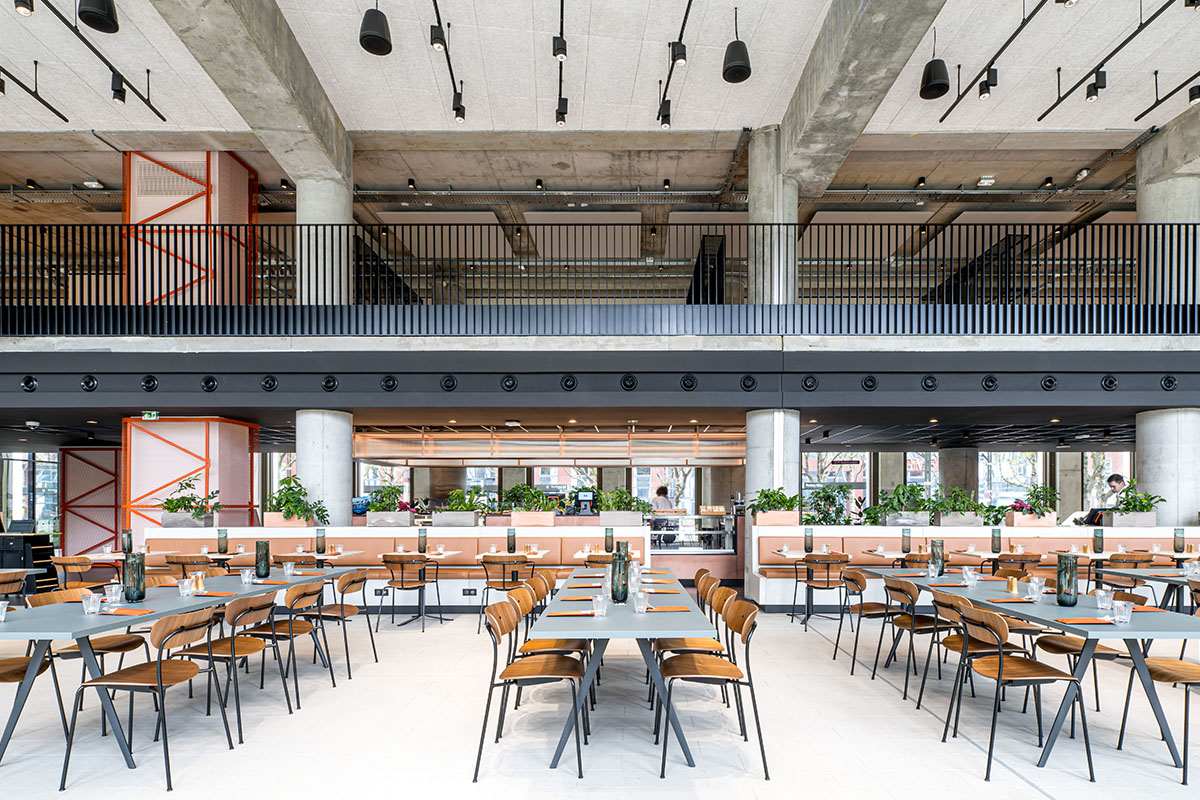 Developers Hammerson kept the charnel house on view to the public after the building was complete|Ahead of work on Allen & Overy’s offices in Spital Square a charnel, or bone storage, house was found|The well-preserved south tower structure meant a delay to the project and increased costs|Developers knew the remains of Bermondsey Abbey were below the Bermondsey Square development|The Spital Square development was built on the site of the well-documented St Mary Spital complex|The St Mary Spital complex included an Augustinian priory, an infirmary, a church and a cemetery|Along with the south tower of Bermondsey Abbey, parts of a Tudor mansion were found before work began|The south tower of Bermondsey Abbey, part of which is now on display at the Del’Aziz eatery|Archaeology costs added £2m to the price of the Bermondsey Square project before lost rent was factored in|The public can even go into the 14th-century charnel house itself on Open House Day in London||
Developers Hammerson kept the charnel house on view to the public after the building was complete|Ahead of work on Allen & Overy’s offices in Spital Square a charnel, or bone storage, house was found|The well-preserved south tower structure meant a delay to the project and increased costs|Developers knew the remains of Bermondsey Abbey were below the Bermondsey Square development|The Spital Square development was built on the site of the well-documented St Mary Spital complex|The St Mary Spital complex included an Augustinian priory, an infirmary, a church and a cemetery|Along with the south tower of Bermondsey Abbey, parts of a Tudor mansion were found before work began|The south tower of Bermondsey Abbey, part of which is now on display at the Del’Aziz eatery|Archaeology costs added £2m to the price of the Bermondsey Square project before lost rent was factored in|The public can even go into the 14th-century charnel house itself on Open House Day in London||
Ancient ruins found below sites that have been earmarked for building projects can throw up fascinating insights into how our ancestors lived – and cost developers a small fortune
A soggy winter’s day in the muddy oblong soon to be London Bridge Place, and a slew of corpses has been found where the building – the Shard’s little brother – will soon rise. These unfortunates, piled up any which way, are the victims of medical techniques employed by medieval surgeons at St Thomas’ Hospital. “They’re not lined up,” says Patrick Williams, a senior project manager for Turner & Townsend. “Basically, if the doctors got it wrong they were
just hoofed out the back door into the garden. When the pit was full, they covered it over.”
The careful exhumation of the bodies is one part of archaeological work that the developers must fund to comply with planning conditions set down by Southwark Council. And the corpses must be reburied according to Ministry of Justice laws.
Sellar Property Group (SPG), the building’s developer, isn’t alone. Since 1990, the planning process has required developers to take care of Britain’s buried heritage. The current system – new planning guidance (PPS 5 and Practice Guide) was introduced in March last year – means developers must pay for an elaborate chain of assessment, investigation, analysis and public archiving of anything found on the site, including interesting historic buildings that are to be dismantled. As it happens, the developer’s archaeological consultant, the Museum of London Archaeological Service (MoLAS) has found something far more interesting than these unfortunate former patients: the remains of a desirable chunk of Roman real estate from 80AD. This is an early find, from around the time the invaders from the south finally conquered Britain. The size of the remains and the existence of a hypocaust (under-floor heating system) suggest this was the home of someone important – perhaps a merchant, military man
or local administrator.
Also discovered on the site are two Roman corpses. Only one of these had a proper burial, his hands folded across his chest. The other has been stuffed between the walls of two buildings. “When the Romans were here, Southwark was
a series of islands,” says Derek Seeley, a senior contract manager with MoLAS, who is in charge of the project. “The low bridging point for this gravel island [to Londinium] was where Southwark Cathedral is now and it extended all the way to the current London Bridge station.”
This habitable hump in the marshes and mudflats of a messier, broader Thames pretty much corresponded with present-day Borough. So while the finds are significant, they were expected. To avoid costly surprises, developers have got used to commissioning surveys before they buy land or plan a development. But it’s not always easy to predict the extent of an archaeological find.
For example, the Igloo Regeneration Partnership knew the remains of Bermondsey Abbey were beneath its Bermondsey Square development, which was completed in 2008. In fact, the ancient remains were the reason no one had taken on the project before. Nonetheless, the sheer extent of what was uncovered, including the early 11th-century building’s south tower and nearby buildings, including foundations of a nearby Tudor mansion, was costly and caused delays. Robert Knight, the Igloo national construction director, says archaeology held up the development by two years and cost around £2m – before the price of delays. Almost as a trophy, the remains of the tower are preserved behind glass in a branch of the deli chain Del’Aziz, which is now on the site.
Whether a developer knows what’s in store or not, it will – normally aided by an archaeological services firm like MoLAS – contact the county archaeologist early in the planning process with a desk-based assessment of what is likely to be beneath the ground. This will reveal what is known about the area through historical records, nearby excavation and old maps. In London Bridge Place, work on the Jubilee Line until 1999 provided a major hint of what was to come. Reason to suspect a site is of interest will trigger an onsite evaluation, an attempt to ascertain what lies below ground. This will usually involve some element of excavation such as digging trenches, but could also include field-walking or a geophysical survey. Two pits at London Bridge Place immediately struck Roman masonry.
If, as here, the onsite evaluation turns up “positive,” the developer is in it for the long haul and will have to fund a potentially long and involved excavation, recording and analysis process. Still, the cost of the archaeology can pale in comparison with a significant delay.
For that reason, much of the value of the consultant archaeologist, beyond working as a planning consultant, is secondary to their skill at multitasking: the trickier part is finding a way of excavating the site while keeping the work on track, says Chris Thomas, also with MoLAS. “Especially in London, delays that prevent renting out the building on schedule will be more significant than any archaeological costs themselves,” he says.
So at London Bridge Place, Seeley and groundworks contractor Keltbray have carefully planned to keep work on schedule. As part of phase I, which runs from October 2010 to March this year, MoLAS archaeologists are digging up and recording findings in the 14 pits where the building’s piles will be sunk. They will then retreat for a while as the ground-floor slab is put in, then map out the rest of the dig in phase II – which will be three months’ more work starting in July – beneath the rising building.
Even if a site has an interesting history, buried evidence may already be too decayed to recover, and the developer could be off the hook at the desk-based assessment stage. Buildings with large basements from the Victorian era – before planning rules got serious about archaeology – may have eliminated strata of history. Finds of national importance are safe from destruction today, though. As with London Bridge Place, a moderately significant find, the local authority can order its excavation, recording and archival.
But if English Heritage decides or indicates that the buried site is a Scheduled Ancient Monument, it has similar protection as a listed building and must be maintained for future generations.
When Hammerson was developing new offices for law firm Allen & Overy in Spital Square in the City, Thomas and his colleagues discovered an incredible early 14th-century charnel, or bone storage, house. It was part of the well-recorded St Mary Spital complex, which also included an Augustinian priory, an infirmary, a church and a cemetery – which were all known about. However, the well-preserved state of the 12m x 6m charnel house surprised the archaeologists. It meant that Hammerson had to replan the building’s basement. In theory, the local authority could block a development altogether, but experts such as Robert Whytehead, the English Heritage regional archaeologist for London, say that the new building and the historical asset can be accommodated – if the developer can afford it.“Engineers say, ‘give us the money we can solve the problem,’” says Whytehead.
In fact, Hammerson went further, volunteering to keep the charnel house on show to the public through glass with an explanatory panel. It is a popular attraction, and on the annual Open House weekend, sightseers can even have a look inside.
Back at London Bridge Place, archaeologists are searching for finds that help explain Londoners’ past: artefacts, or the remains of walls, trenches and roads. As they work, the horizontal and vertical location of features needs to be mapped out for the next stage – analysis. Seeley and his team will look at the information and store artefacts in the museum’s London Archaeological Archive and Research Centre before he produces a report, which could take a year or more. All this is done on SPG’s dollar.
Turner & Townsend’s Williams says the Shard developer plans to incorporate cobble stones from an old road into the public area around the new skyscrapers and may submit artefacts to the local London Underground display.
But when the two new towers are built, that is about all that will remain visible. Long before the office workers move into their new headquarters, the earthbound remains of Romans and medieval citizens alike will disappear once more beneath a long desirable slice of London’s turf. Meanwhile, the artefacts and the knowledge that archaeologists have gleaned from what they left behind will live on in the Museum of London.



















